Haddington, East Lothian, Scotland, UK 作者: 来源: 发布时间:2021-07-29
I. Population and Area
Continent: Europe
Country: The U.K
State/Province: Scotland
City/Town: Haddington, East Lothian
Total Area: 1.093 (sq mi)
Population in 2018: 9.944 (thousand)
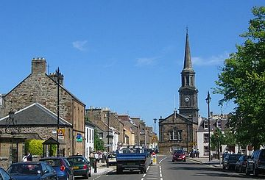
II. Natural Geography (environment and resources)
Geography
East Lothian is predominantly rural. It has 40 miles (64 km) of coastline where the towns of Musselburgh, Prestonpans, Cockenzie and Port Seton, Gullane, North Berwick and Dunbar lie along the coast of the Firth of Forth. The coast has several headlands and bays, most notably Gosford Bay, Aberlady Bay, Gullane Point, Sandy Hirst, Tyne Mouth, Belhaven Bay, Barns Ness, Chapel Point and Torness Point. There are several small islands off the coast north of North Berwick, the largest of these being Fidra, Lamb, Craigleith and Bass Rock.
Only two towns are landlocked, Tranent and Haddington. To the south are the Lammermuir Hills along the boundary with Berwickshire; it is here that Meikle Says Law, the highest point in the county at 535 metres (1,755 ft), can be found. The River Tyne flows through Haddington and several of East Lothian's villages, reaching the Firth of Forth near Belhaven. The River Esk flows through Inveresk and Musselburgh where it empties at the north of the town into the Firth of Forth. Major bodies of water include Pressmennan Lake, the Whiteadder Reservoir, Hopes Reservoir, Stobshiel Reservoir and Lammerloch Reservoir.
Bus
Haddington sits 1 km south of the A1 dual carriageway linking Edinburgh to London. The town is currently served by the bus companies Borders Buses, Prentice Coaches, Eve Coaches and East Coast Buses. These buses facilitate travel to Edinburgh, Berwick-upon-Tweed, and several other towns and villages in East Lothian. Since the withdrawal of many First Scotland East services in June 2012, the contracts for the 121 Haddington to North Berwick and the 123 Gifford Circle passed back to the Haddington-based firm Prentice Coaches. Haddington was once served by a railway branch line which carried passengers for over a century from 1846 to 1949. There has been proposals to reopen or extend a railway line to Haddington to ease road congestion, but nothing has came to fruition in regards to this.
Rail
The Haddington railway line was a branch from the East Coast Main Line at Longniddry and terminated at Haddington railway station and freight depot in the area between West Road and Hospital Road. The line was 4 13⁄16 miles (7.7 kilometres) in length and had stations at Coatyburn Siding and Laverocklaw Siding before terminating in Haddington. The line was opened on 22 June 1846. The branch had only a single track, though bridges and embankments were built to allow for a double track. Passengers from Haddington were required to alight at Longniddry and change trains in order to travel to Edinburgh.
The Haddington branch line and station were damaged during the flood of 1948 and though both passenger and freight services were reinstated, British Rail opted to remove rail services to the public due to competition from bus services and dwindling passenger numbers. Passenger services ended on 29 December 1949. The use of the railway line for freight continued until March 1968. The larger Victorian station building was demolished; a smaller older building, parts of the platform structure, and embankment walls remain. These are recognisable by their distinctive red-brick appearance, and can be seen from West Road, Somnerfield Court, and the industrial area south of Hospital Road.
The land occupied by Haddington's railway line is owned by East Lothian Council and is used by walkers, cyclists and horse-riders in the section of the line between Longniddry station and the St Lawrence area of Haddington. The eastern terminus of the line is occupied by industrial units and scrub vegetation. A campaign to reopen Haddington's railway service is led by the group RAGES (Rail Action Group East of Scotland). Since the closure of the station in the 1940s (isolated as it then was at the western extremity of Haddington), the town has since expanded significantly. Between 1951 and 1981, the population of the town grew by 54%. It remains to be seen whether further expansion of the town will lead to a reinstatement of Haddington's railway line, since there are congestion issues on both the East Coast Main Line and at Edinburgh Waverley railway station.
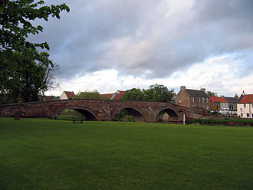
III.Economy
Gross Value Added
Figure 3.37 displays Gross Value Added (GVA) per employee in East Lothian and Scotland. GVA is a measure of the value of goods and services produced in an area. GVA per head has been consistently lower in East Lothian than Scotland as a whole.

Economic output from Lothian area (Edinburgh, East Lothian, Midlothian, and West Lothian) was calculated to be £23 billion in 2012. This represented 22% of the total Scottish Gross Value Added from a region with 16% of the national population. East Lothian is estimated to have contributed to 5% of this £23 billion. Figure 3.38 shows the economic output of the Lothian region and a breakdown of local authorities within. Figure 3.39 shows the gross annual turnover by business sector in East. Lothian. Wholesale, retail, repairs and primary industries have the highest turnovers with £572 billion and £604 billion respectively.

Reference Website:
file:///C:/Users/%E9%98%BF%E9%BE%99/AppData/Local/Temp/MicrosoftEdgeDownloads/9e4e94a9-12d2-44a8-9751-5632782b5dbc/East_Lothian_by_Numbers___Economy_and_Income.pdf
IV. Industrial Characterisitics
Major industries:
Michael Cox
Manufacturing industrial activity during the past 55 years can viewed in four parts: the three major construction projects, namely the Dunbar cement works and the Cockenzie and Torness power stations; the decline of many traditional industries; the push to have an electrical/electronic/precision engineering presence; and the development of small firms.
Major works
There had been a small limeworks operation at Oxwellmains, Dunbar, before a cement works was proposed in 1958, and approved in 1960. The limestone there is the only kind suitable for the manufacture of cement in Scotland, with enough reserves to last into the 21st century. The plant was completed in 1963. By 1970, the limestone to the south of the railway had been worked out; Associated Portland Cement Manufacturers built a new stretch of the A1 to the south of the works and railway, in return for permission to extend and so maximise the potential of the quarry. Major investment in 1983 on a new production plant resulted in the loss of some 300 jobs.
The Cockenzie (although located within Prestonpans) 1200 megawatt coal fired power station was built on a former colliery site. Work started in 1962, with the power station operational from 1966, and officially opened in 1967. Linked to its completion was a noticeable feature on landscape – the 275kV overhead power lines. Initially coal was obtained from the Lothian coalfields, but from the 1980s supplies came from the nearby Blindwells opencast quarry and elsewhere.
Construction work on the 1300 megawatt Advanced Gas-Cooled Reactor (AGR) type nuclear power station at Torness began in 1978. The power station went ‘critical’ in 1988.
These three projects saw a large influx of specialised construction workers coming into the county. In the case of Torness, 500 of those working on the site were housed in a ‘construction village’ built at nearby Thurston Mains. The impact of these works was such that, at the end of the Torness construction phase, special provision was made by the council in an attempt to minimise the effects on the county’s economy.
Major projects and related introductions:
Library Museum Archive Archaeoogy
History is not just a set of events that take place in isolation. It is about how those events shaped the people who lived through them, and also about the people who made them happen. Here we will gradually be adding pages about some of those who have found themselves a place in the history of East Lothian, and we welcome your suggestions and contributions for new articles.
The rich farmland and fishing grounds of East Lothian have always attracted people, and there is evidence of settlement here reaching as far back as the Stone Age. Our documentary evidence only covers more recent times, however! Surname research shows that many settlers over the last thousand years came from Europe and England. Norman families took over big estates in the 13th century by invitation from the king: de Gifford, Broun, Martine. Others came as Huguenot refugees, merchants and skilled tradesmen.
Reference Website:
https://el4.org.uk/county/economy/manufacturing-industries/
https://www.johngraycentre.org/people/
V. Attractions
1. Scottish Birdwatching Resource Centre:
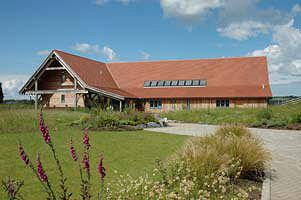
Waterston House – also known as The Scottish Birdwatching Resource Centre – is the headquarters of the SOC. Situated to the west of Aberlady village, just off the scenic coast road from Edinburgh, the centre offers panoramic views of Aberlady Bay Local Nature Reserve and houses the George Waterston Library. The library is open to the general public, and houses the largest collection of ornithological reference books and journals in Scotland. A small retail area offers optical equipment, Club merchandise, bird seed, hand-carved wooden birds, wildlife art books, new and second-hand natural history books and bird guides, including the SOC's award-winning 2007 publication The Birds of Scotland. Hot and cold drinks are available in the foyer. The building also houses the Donald Watson art gallery which showcases the best national and international wildlife artists throughout the year.
2. Kentwood Craft Brewery:
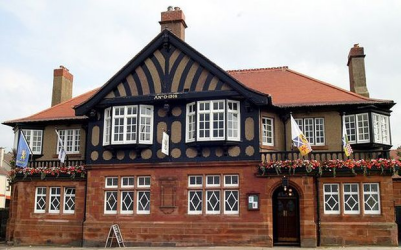
The Kentwood Craft Microbrewery is situated within The Goth public house. Ales produced in the brewery are served on tap direct from casks. You can watch the brewers at work through the large glass viewing panels. Beer tasting & Brew day events can be booked throughout the year.
3. Scottish Seabird Centre:
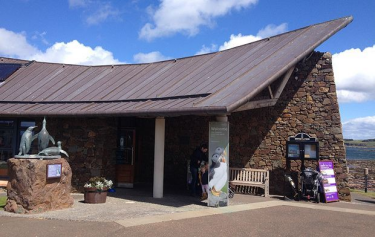
Perched on a rocky outcrop at North Berwick Harbour, the Seabird Centre offers remote viewing of a variety of seabirds and wildlife via live cameras installed on islands in the Forth estuary, as well as boat trips out to the islands. There's a Discovery Centre featuring a Wildlife Theatre, Scope Deck, Flyway Tunnel and a Turtle and Ray Zone as well as a Kids' Zone for wild play and a Kids' Corner for quieter playtime.
Reference Website:
https://www.list.co.uk/places/tourist-attractions/location:Haddington(55.9521,-2.7782)/
VI. History
An account of the parish of Haddington was drawn up by the Rev. Dr. Barclay, and published by the Society of Scottish Antiquaries in 1785. James Miller published Lamp of Lothian a history of Haddington in 1844. A new edition was reprinted in 1900 under the name Lamp of Lothian: or, the history of Haddington, in connection with the Public Affairs of East Lothian and of Scotland, from the earliest records to 1844. A goat appears on the seal and on the coat of arms of Haddington. John Martine wrote Reminiscences of the royal burgh of Haddington and old East Lothian agriculturists in 1883.
The town centre largely retains its historic street plan with Court Street, High Street, Market Street and Hardgate defining the edges of the original open triangular medieval market place, divided by a central island of buildings developed from the 16th century onwards on the site of market stalls.To the north and south the medieval rigg pattern of burgage plots can still be observed with narrow buildings fronting the main streets and long plots behind stretching back, originally to the line of the old town walls, accessed by small closes and pends.
The historic importance of the town's relatively unaltered medieval plan and significant survival of historic buildings was recognised as early as the 1950s, with Haddington subject to an Improvement Scheme, Scotland's earliest, which saw many period properties rehabilitated by the Town Council (under the leadership of Frank Tindall as Director of Planning) and a pioneering town colour scheme developed, resulting in the distinctive and colourful townscape seen today. Some comprehensive redevelopment did occur, chiefly around Newton Port and Hardgate to allow for widening of these narrow streets to improve motor traffic flow. This included the demolition of Bothwell Castle and its dovecote in 1955, the land now forming part of Hardgate Park. Today the whole town centre is a conservation area with a high proportion of listed buildings, some dating back to the C16th, and the redevelopment and infill schemes undertaken since the 1950s have largely been in a sympathetic vernacular style which has maintained the town's historic character.
VII. Culture
Art and artists associated with Haddington include:
Stephen Baillie, John Guthrie Spence Smith, William Darling McKay, Colin Thoms, William George Gillies, Daisy R. Sharp Robert Noble, Shirley M. Maud, Walter Dexter, and Haugh.
On film
Films which have shots of Haddington include:
Lothian Landscape (1974) 21 mins, colour. Narrated by Gordon Jackson and
Lothians Part II, the: Industries and Towns (1956+) silent.
Sport and leisure
Haddington is home to East Lothian Amateur Boxing Club, the East of Scotland football club Haddington Athletic and Haddington RFC, currently playing in Scotland Premiership Division Three.
At the end of March 2012, the town's library relocated to the John Gray Centre in Lodge Street, an extensively reconstructed and restored complex of historic buildings including the town's former granary. In addition to the lending library the Centre comprises East Lothian Council's Historical Archives, Local History Collections and Reading Room, a new museum of East Lothian (with a temporary exhibition gallery), a computer suite and community room. The Centre is named after a local minister whose bequest of books and money in 1717 gave the town one of the earliest community libraries in Scotland.
VIII. Other information
Amisfield House was located east of Haddington, south of the River Tyne. Designed by architect Isaac Ware and built of Garvald red freestone for Colonel Francis Charteris, it was described in The Buildings of Scotland as "the most important building of the orthodox Palladian school in Scotland." John Henderson built the walled garden in 1783, and the castellated stable block in 1785. The park in front of the house, possibly landscaped by James Bowie, is today entirely ploughed. A victim of dry rot, the house was demolished in 1928.
All that remains of Amisfield today are the summer house, walled garden, ice house, chapel, and gates.Lennoxlove House, a historic thirteenth-century house and estate, lies 1⁄2 mile (800 metres) south of Haddington. Built by the Giffards of Yester, it was originally named Lethington. It was once home to the Maitland family, notably Sir Richard Maitland, and his son William Maitland of Lethington, Secretary of State to Mary, Queen of Scots'. The Maitlands left Lennoxlove in the seventeenth century, and it is now the seat of the Duke of Hamilton and Brandon.
The world's earliest surviving records of a lodge of free gardeners come from Haddington, in 1676.
The Parish Church of St Mary's is today part of the Church of Scotland, but includes an Episcopalian chapel, the Lauderdale Aisle, containing the mausoleum of the Maitland Earls of Lauderdale. It is the longest parish church in Scotland and is in regular use for worship and musical events. It is directly adjacent to the River Tyne, beside the twelfth century Nungate Bridge.
The present building (built with red sandstone from nearby Garvald) was started in 1375 (an earlier St Mary's Church having been destroyed by the English in 1356), and consecrated in 1410, despite building work not being finished until 1487. The church was partially destroyed during the 1548-49 Siege of Haddington that followed the Rough Wooing of Henry VIII, and on the advice of John Knox, it was restored "frae the tower to the West door". Thus the nave became the church and the choir and transepts were left ruined until the whole church was restored in the 1970s. The Lammermuir pipe organ was built in 1990.
A set of eight bells hung for full change ringing was installed for the Millennium.
Haddington War Memorial stands at the west entrance to the churchyard.
IX. Contact information
Mayor/Officer: Shamin Akhtar
Tel: 07718 669 395
Mail: sakhtar@eastlothian.gov.uk
Reference Website:
https://www.eastlothian.gov.uk/councillors/10040/shamin_akhtar
